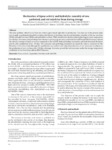Por favor, use este identificador para citar o enlazar este ítem:
http://www.alice.cnptia.embrapa.br/alice/handle/doc/959579Registro completo de metadatos
| Campo DC | Valor | Lengua/Idioma |
|---|---|---|
| dc.contributor.author | LACERDA, D. B. C. L. | pt_BR |
| dc.contributor.author | SOARES JÚNIOR, M. S. | pt_BR |
| dc.contributor.author | BASSINELLO, P. Z. | pt_BR |
| dc.contributor.author | CALIARI, M. | pt_BR |
| dc.contributor.author | CASTRO, M. V. L. | pt_BR |
| dc.date.accessioned | 2013-10-19T00:07:47Z | - |
| dc.date.available | 2013-10-19T00:07:47Z | - |
| dc.date.created | 2013-06-10 | pt_BR |
| dc.date.issued | 2013 | pt_BR |
| dc.identifier.citation | Food Science and Technology, Campinas, v. 33, n. 2, p. 376-381, Apr./June 2013. | pt_BR |
| dc.identifier.issn | 0101-2061 | pt_BR |
| dc.identifier.uri | http://www.alice.cnptia.embrapa.br/alice/handle/doc/959579 | pt_BR |
| dc.description | The main problem related to rice bran use is that it goes rancid right after its production. The objective of the present study was to apply a mathematical model to evaluate the kinetics of the lipase activity and hydrolytic rancidity of the raw rice bran (RRB), extruded rice bran (ERB), and parboiled rice bran (PRB) stored in low density polyethylene bags at room temperature for 180 days. Extrusion and parboiling were efficient in preventing free fatty acid formationin ERB and PRB.Extrusion reduced the velocity constant of lipase activity as compared to that of RRB while parboiling increased it, and both decreased the lipase activity after equilibrium from 150 days. The extrusion and parboiling treatments increased the velocity constants for the liberation of free fatty acids although the equilibrium was reached with reduced production of free fatty acids in relation to the production of raw rice bran after 150 days ofstorage. Extrusion proved the best treatment under the storage temperature conditions of rice bran from cultivar BRS Primavera. | pt_BR |
| dc.language.iso | eng | eng |
| dc.rights | openAccess | eng |
| dc.title | The kinetics of lipase activity and hydrolytic rancidity of raw, parboiled, and extruded rice bran during storage. | pt_BR |
| dc.type | Artigo de periódico | pt_BR |
| dc.date.updated | 2013-10-19T00:07:47Z | pt_BR |
| dc.subject.thesagro | Arroz | pt_BR |
| dc.subject.thesagro | Oryza sativa | pt_BR |
| dc.subject.thesagro | Ácido graxo | pt_BR |
| dc.subject.thesagro | Subproduto | pt_BR |
| dc.subject.nalthesaurus | Rice | pt_BR |
| dc.subject.nalthesaurus | Free fatty acids | pt_BR |
| dc.subject.nalthesaurus | Byproducts | pt_BR |
| dc.subject.nalthesaurus | Shelf life | pt_BR |
| riaa.ainfo.id | 959579 | pt_BR |
| riaa.ainfo.lastupdate | 2013-10-18 | pt_BR |
| dc.identifier.doi | http://dx.doi.org/10.1590/S0101-20612013005000053 | pt_BR |
| dc.contributor.institution | DIRACY BETÂNIA CAVALCANTI LEMOS LACERDA, UFG; MANOEL SOARES SOARES JÚNIOR, UFG; PRISCILA ZACZUK BASSINELLO, CNPAF; MÁRCIO CALIARI, UFG; MAIZA VIEIRA LEÃO CASTRO, UFG. | pt_BR |
| Aparece en las colecciones: | Artigo em periódico indexado (CNPAF)  | |
Ficheros en este ítem:
| Fichero | Descripción | Tamaño | Formato | |
|---|---|---|---|---|
| fst.pdf | 449.06 kB | Adobe PDF |  Visualizar/Abrir |









